Family : Ophichthidae

Text © Giuseppe Mazza

English translation by Mario Beltramini
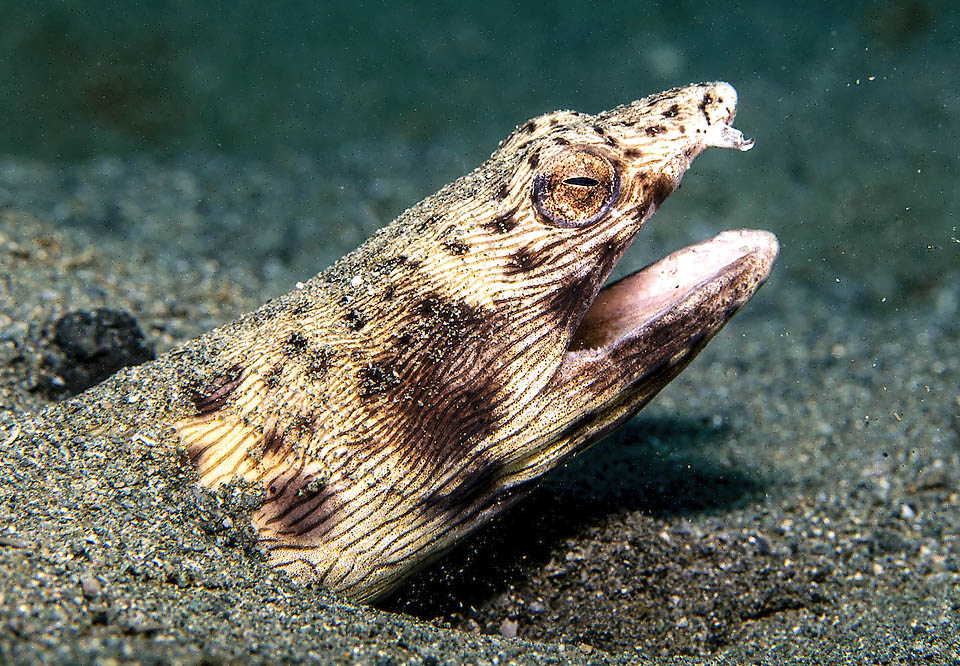
The Spotted snake eel (Ophichthus ophis) is a solitary species, little common but with a vast range along the tropical and temperate coasts of Atlantic © www.carlosestape.photoshelter.com
At first sight the Spotted snake eel, Ophichthus ophis (Linnaeus, 1758), could be mistaken for a sea snake like Hydrophis elegans, as indeed suggests the etymology of the genus Ophichthus, from the Greek “ophis”, snake, and “ichthys”, fish, and even more explicitly the specific term ophis, but evokes also a small moray, for instance Gymnomuraena zebra or Echidna nebulosa, and in fact in 1758 Linnaeus called it Muraena ophis.
Like these it belongs to the class of the Actinopterygii, the ray-finned fish, and to the order of the Anguilliformes, but in the course of evolution has conserved the pectoral fins and is taxonomically closer to the eels than to the morays.
The scholars have then placed this species into the family of the Ophichthidae, that of the snake eels, a group of fish already present in the Lower Eocene, that presently counts about 60 genera and more than 300 species. Marine species, mainly tropical and subtropical, with some members in the fresh waters, that may descend up to 1300 m in depth, where they prey in absolute darkness thanks to their exceptional sense of smell.
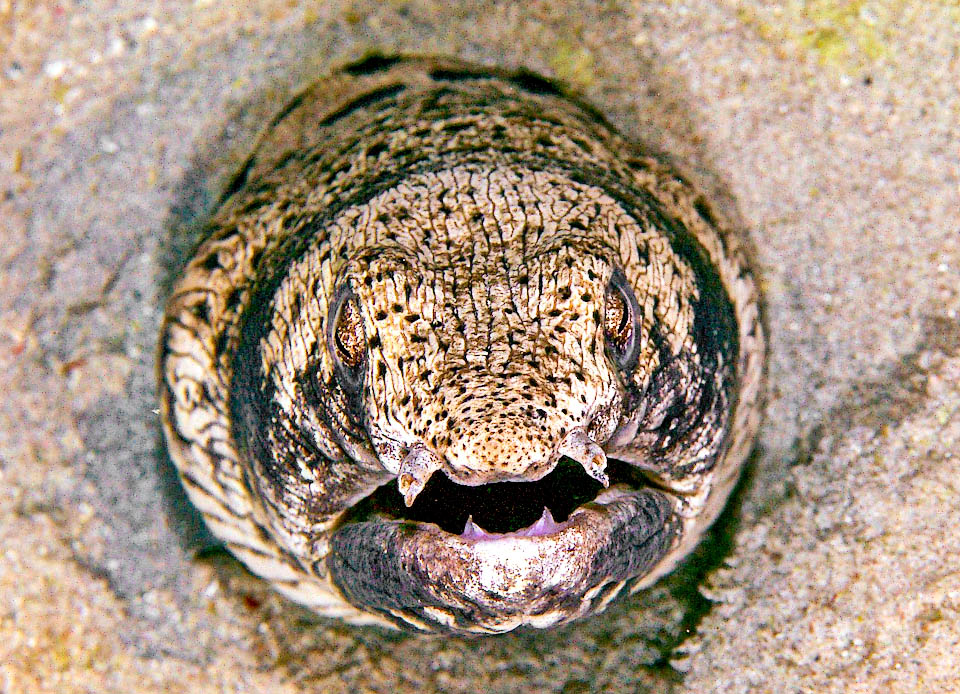
At the den door, dug in the sandy or clayey bottoms, it observes during the light hours the surroundings. Note the showy nostrils for an exceptional sense of smell © www.carlosestape.photoshelter.com
Zoogeography
Ophichthus ophis lives on both sides of the Atlantic. In America it goes swimming from the Bermudas and southern Florida up to the Lesser Antilles and Brazil, and in the Ancient World may be found from Senegal to Angola, with some doubtful reports in the western Mediterranean.
Ecology-Habitat
It is a coastal benthic species, diffused but little common, loving the temperatures included between 19,2 and 27,5 °C and lives solitary in a permanent den dug on soft or clayey sandy seabeds.
It spends the hours of light hidden, at most observing the surroundings with the head that diagonally protrudes from the opening, and only by late night, with the darkness on its side, goes out hunting for octopuses and fishes, moving between 21 and 70 m in depth. Usually it keeps around 50 meters, but for surprising the prey it can move also under the sand and is reported a sighting at 137 m.
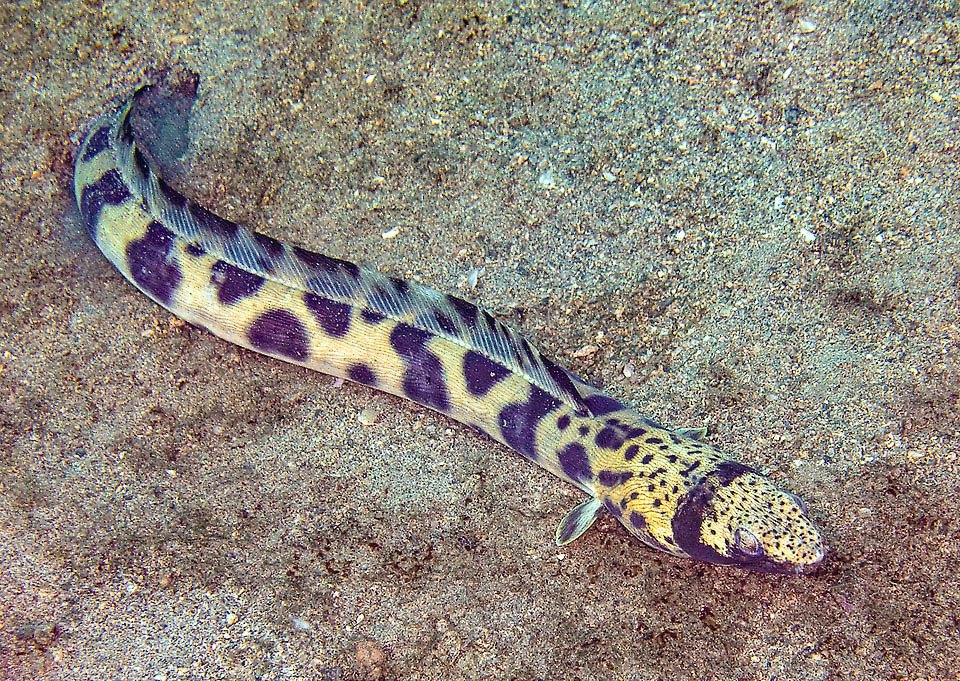
Goes hunting only late at night, with the dark on its side, looking for fish and octopuses © www.carlosestape.photoshelter.com
Morphophysiology
Ophichthus ophis exceptionally reaches the length of 210 cm, but the current size is of about one meter.
The head, with pointed snout, has a big mouth armed by robust conical teeth, present with two rows on the jaws, with others added on the palate.
The anterior nostril is a showy tube looking downwards with a small rocker-like protuberance that helps in localizing the direction of the smells, and the back nostril is delimited by the lip.
As usually happens in the Anguilliformes the pelvic fins are missing. The pectoral ones, similar to spatulae, with a restricted base, are located just over the gill openings. Higher up, at the same level, begins the dorsal, elongated like the anal, but the tail is blunt and has no fins.
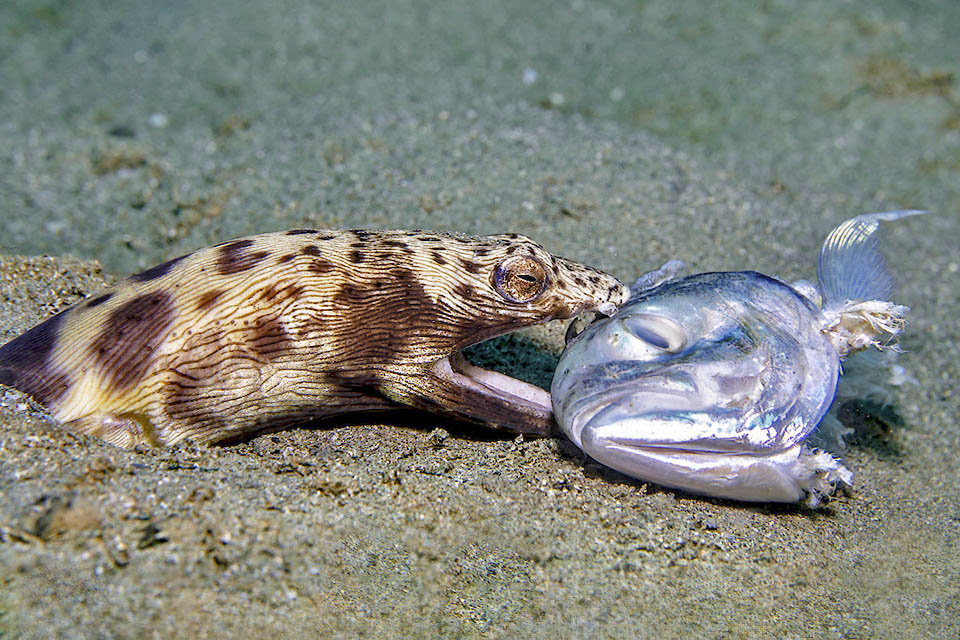
Here with a prey due to disappear in bites, bones included, in its huge mouth © www.carlosestape.photoshelter.com
The body, cylindrical, has on the sides about twenty blackish camouflaging spots and other 25-35 pairs smaller along the base of the dorsal fin. A dark belt finally crosses the nape, preceded and followed by black little spots.
Ethology-Reproductive Biology
The reproductive modes of Ophichthus ophis are little known, apart from the fact that the pairs entrust their fecundated eggs to the currents; in spring or at the beginning of summer.
Also the larvae are pelagic and as they grow they take on the typical shape of the Anguilliformes, called leptocephalus, similar to a transparent leaf of willow, with small head and protruding needle-like teeth. Unlike the normal larvae of the fishes, the leptocephali do not feed on plankton but on tiny food particles they meet floating around in the sea.
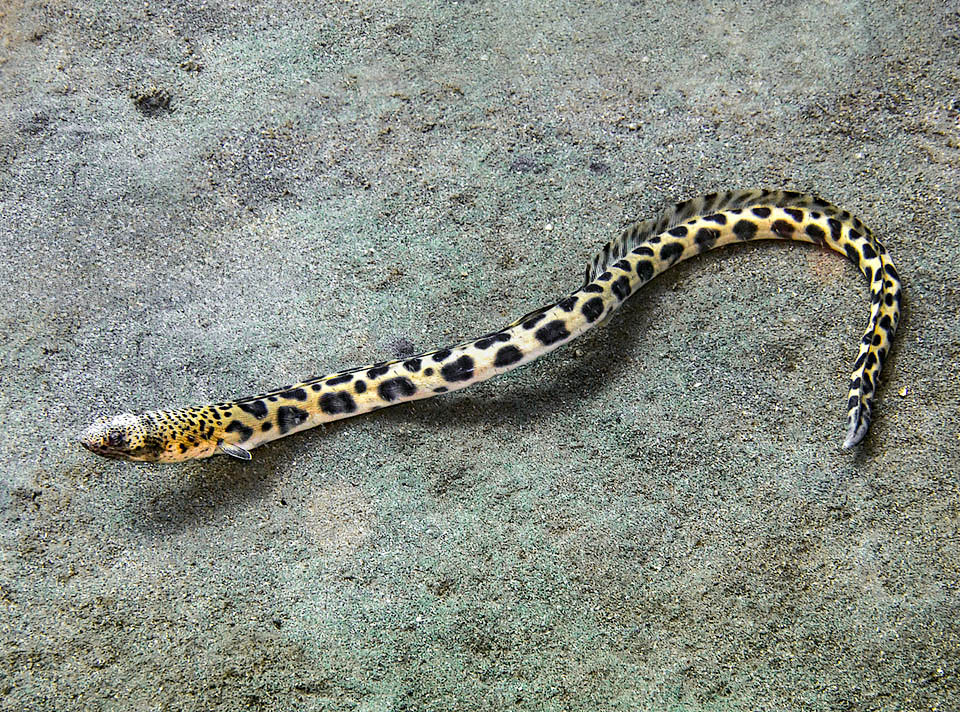
Could be mistaken for a snake or a moray eel, but the presence of the pectoral fins takes it closer taxonomically to the eels © www.carlosestape.photoshelter.com
They can also swim backwards and curl up taking on the appearance of gelatinous cylinders, similar to jellyfishes, that are mainly avoided by the predators.
The resilience of the Spotted snake eel is very low, with a minimum time for doubling the populations of more than 14 years, and the fishing vulnerability index, very high, marks 90 on a scale of 100. In the IUCN Red List of the endangered species, Ophichthus ophis appears however from 2011 as “LC, Least Concern”, considering the ample distribution and the fact that no serious threats are known.
Synonyms
Muraena ophis Linnaeus, 1758; Ophichthys ophis (Linnaeus, 1758); Muraena hauannensis Bloch & Schneider, 1801; Ophisurus havanensis (Bloch & Schneider, 1801); Uranichthys havanensis (Bloch & Schneider, 1801); Anguilla serpens Shaw, 1803; Herpetoichthys sulcatus Kaup, 1856; Uranichthys brachycephalus Poey, 1867; Antobrantia ribeiroi Pinto, 1970.
→ For general information about FISH please click here.
→ For general information about BONY FISH please click here
→ For general information about CARTILAGINOUS FISH please click here.
→ To appreciate the BIODIVERSITY of BONY FISH please click here.
→ To appreciate the BIODIVERSITY of CARTILAGINOUS FISH please click here.
